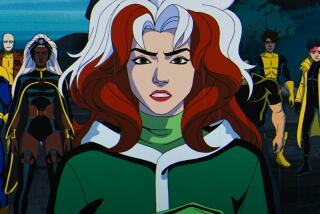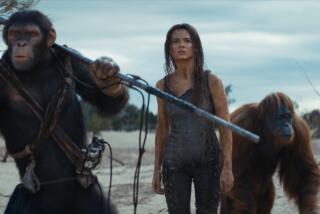Review: What exactly does the sound and fury of Bryan Singer’s ‘X-Men: Apocalypse’ signify?
The new “X-Men: Apocalypse” throws a lot of stuff at you, both literally and metaphorically. Not only are new X-characters introduced and old ones revisited, but an attempt is made to blow up the entire world, which, unsurprisingly, leads to a lot of chaos.
When everything is added up, this seventh 20th Century Fox movie with “X-Men” in the title (and the fourth to be directed by series originator Bryan Singer) is not the well-oiled machine the Disney Marvel movies have become.
Disorganized but engaging, full of visual pyrotechnics and earnest emotion, it is diverting, if not necessarily convincing. And like the Disney Marvels, it does require some knowledge of X-history to be fully understood.
All that chaos comes courtesy of big-time villain Apocalypse (Oscar Isaac, under a whole lot of makeup), ballyhooed in the media material as “the original and most powerful mutant.”
In fact, Apocalypse is so ancient and so potent the movie has to go back 5,000 years to Ancient Egypt to show us this mutant — then called En Sabah Nur — at the height of his powers, lording it over the Nile Valley like the god he believes himself to be.
Things do not go well for Apocalypse, however, and before you can say “what shape is a pyramid?” he’s entombed in one, not to be liberated until 1983, when CIA operative and X-Men collaborator Moira MacTaggert (Rose Byrne) is around to take notes.
Never the most temperate of individuals, Apocalypse is shocked to discover what bad shape civilization is in. Muttering things like, “I have returned,” and “The weak have ruined my world,” he becomes not the first individual to decide to destroy Earth in order to save it.
Powerful though he is, as written by Simon Kinberg, Apocalypse decides he needs help to pull this off. He has his eye on the recruitment of a quartet of mutant sidekicks, his own personal Four Horsemen, including newcomers Psylocke (Olivia Munn), Storm (Alexandra Shipp) and Angel (Ben Hardy.)
For those keeping track, 1983 is exactly a decade after the close of the last X-movie, “X-Men: Days of Future Past,” which ended with the world’s acknowledgement (but not necessarily acceptance) of mutants in their midst.
Charles Xavier, a.k.a. Professor X (James McAvoy) is still involved with his School for Gifted Students, trying to help young mutants adjust to society, while other, old-school mutants are having a tougher time.
Raven/Mystique (Jennifer Lawrence) travels the world incognito, and the ever-potent Erik Lehnsherr (Michael Fassbender) is trying to have a normal life in Poland. Good luck with that, Man Pretending Not to Be Magneto, with Apocalypse casting covetous eyes in your direction.
The new young mutants are not only lining up on the side of evil, there are newcomers at the school too, though they all have understandable difficulty controlling their powers. Say hello to younger versions of the following:
Jean Grey (Sophie Turner), a telepathic whiz who keeps having bad dreams where, she convincingly reports, “I saw the end of the world.”
Scott Summers, a.k.a. Cyclops (Tye Sheridan), whose eyes emit rays of the most damaging sort. Ditto for Jubilation Lee/Jubilee (Lana Condor), whose hands are deadly weapons.
Kurt Wagner/Nightcrawler (Kodi Smit-McPhee), a blue-skinned German mutant with a long tail and teleportation powers, whose duties include being a bit of comic relief.
Getting this new generation of X-Men into position to carry the franchise as the older stars transition to other, X-less roles, was doubtless one of the reasons “X-Men: Apocalypse” was given the go-ahead.
Unfortunately for this idea, however, is that though the young people are fine, it’s the veteran X-folks who hold our attention. Lawrence, Fassbender and Hugh Jackman (in a brief but dynamic unbilled cameo as Wolverine) make the most lasting impact here.
And though all that destroying worlds stuff was not easy to create — principal photography in Montreal used seven sound stages, 116,500 square feet plus locations around the city — “X-Men: Apocalypse” only sporadically catches fire.
One of the moments it does is worth a tip of the hat. Impeccably choreographed to the Eurythmics’ “Sweet Dreams,” the faster-than-a-speeding bullet Quicksilver (Evan Peters) pulls off a daring two-minute rescue scene (evocative of a similar scene in “X-Men: Days of Future Past”) that director Singer reports took over a month and a half to shoot. Would that the entire film was this much fun.
MPAA rating: PG-13 for sequences of violence, action and destruction, brief strong language and some suggestive images.
Running time: 2 hours, 24 minutes.
In general release.
More to Read
Only good movies
Get the Indie Focus newsletter, Mark Olsen's weekly guide to the world of cinema.
You may occasionally receive promotional content from the Los Angeles Times.









